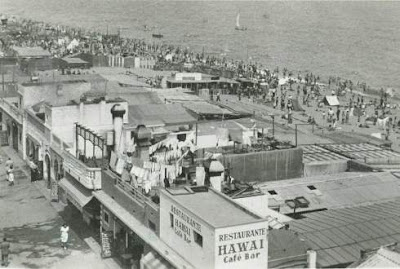We are at St. Sebastià beach. Today,
the beaches of Barcelona are known for its large areas of sand that allows
people a place to rest, play and leisure. However, this has not always been
like this. Until the mid-eighties, Barcelona had a kind of barrier between the
city and the sea, which was constituted by the bars or merenderos and
sheds.
 |
| "Xiringuitos" |
At that time Barceloneta began to
leave behind its history as an industrial and fisherman district, and began to
focus on entertainment with baths and food,. It is then when they began to hear
about a project called Plan de la Ribera (Plan
Parcial de Ordenación Urbana de la Ribera de Barcelona). It was a large project that
anticipated the redevelopment of the maritime façade of Barceloneta. This
project did not please the neighborhood residents who clearly opposed.
 |
| People having something to drink |
Despite this local revolt in 1985
ended this plan was approved, which called for the disappearance of factories
like The Machinist and the redevelopment and regeneration of the urban planning
of the neighborhood.
The most radical change, however,
was the demolition of sheds, the bars and baths, between 1986 and 1992. In
return, they opened new areas such as the Moll de la Barceloneta. This caused
the decline of the neighborhood, as they destroyed the economic center of the neighborhood, which was devoted to leisure, and now would be forced to focus on
the tourism sector.
In relation to the demolition of
stalls and merenderos because of the Coastal Act of 1988, there is
controversy regarding the new W Hotel. It is a building located within 20m of
the sea, something prohibited by this law. However, the owners of this hotel
play with advantage, as the building is built in the grounds of the Port
Authority, where it can be built on land reclaimed from the sea, but that means
that they have privatized land which belongs to public domain. However, the law
states that you can only build port facilities.
 |
| W Hotel |
The controversial part of the
traditional legislation (in the sense that the old bars have gone to ground,
but a five star hotel is permitted) has also become a controversy over social
image. Some argue that the situation of this hotel is not random and that is
has been built in an area that, slowly, had been transformed into a nudist
beach, and that was an area frequented by homosexuals, so it seems that the
building has been placed there to prevent this and to give the beach a modern
look.
Beyond these controversies, the
polemic doesn’t end there. Critics of this hotel are not few: surfers and
environmentalists argue that the resort changed ocean currents due to the
extension of the breakwater that also changes the winds, which doesn’t allow
the use of Catalan skate or windsurfing.
 |
| El Bierzo's bar |
Today, when you walk by the beach,
you come across a lot of bars with loud music that, rather than a beach, give
you the feeling of being in a club. Older establishments that used to offer
only sandwiches, fresh cans and chips, have recently become authentic modern
beach clubs. Now it is full of small establishments with simplistic shapes,
lights, colors, tropical plants and modern music which seek for the attention
of those who pass by. And In order to satisfy customers, they have expanded
dining menus and developed their different services to provide the most
innovative facilities in order to attract people and beat the competition.
Cap comentari:
Publica un comentari a l'entrada